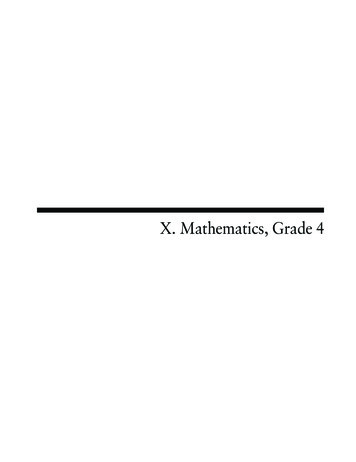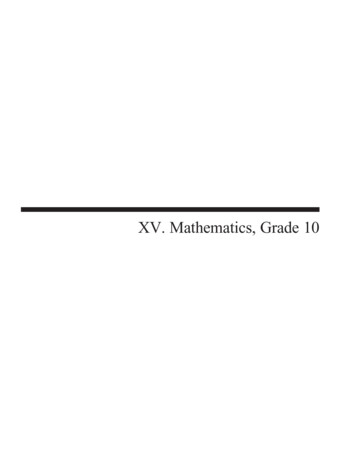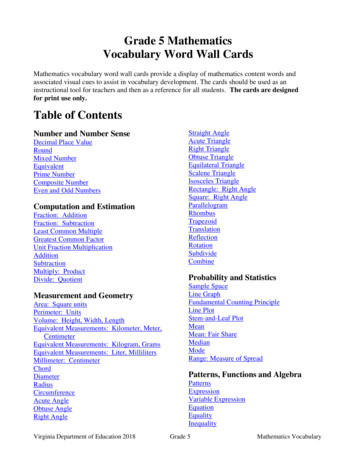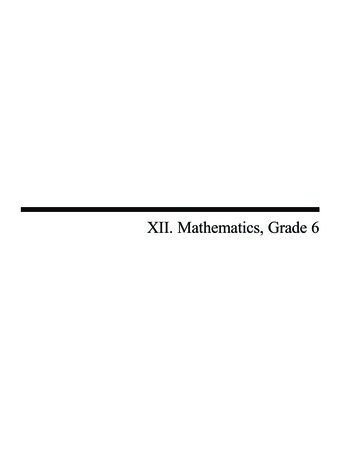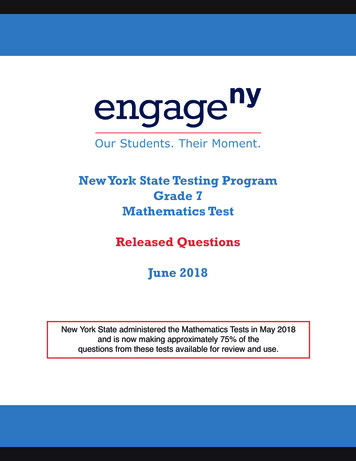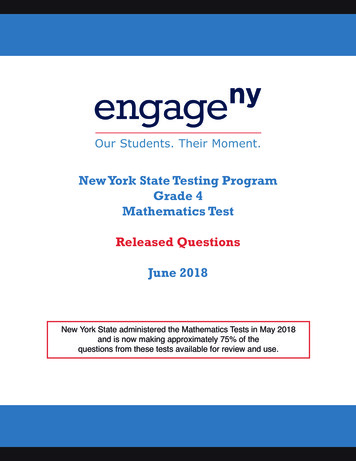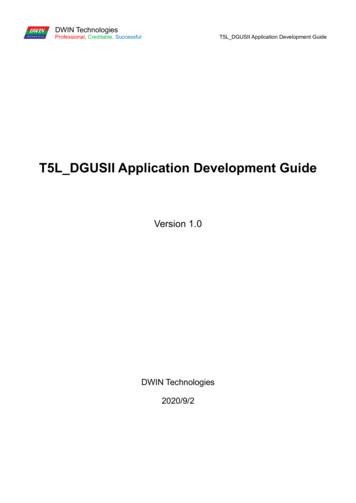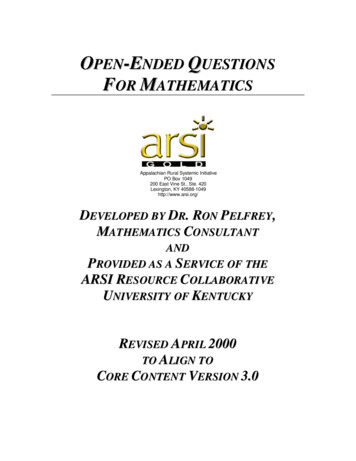
Transcription
MathematicsGrade 9Workbooks, ANA Exemplars and ANA Papers Alignment tothe 2013 Work SchedulesCURRICULUM GET DIRECTORATE, HEAD OFFICECURRICULUM GET DIRECTORATE, HEAD OFFICEPage 0
TABLE OF CONTENTS1.Notes for the teacher . 2Section 12.Table of contents for Grade 9 Workbook 1: Term 1 & 2 . 33.Table of contents for Grade 9 Workbook 2: Term 3 & 4 . 4Section 24.Alignment of Workbook Activities to the Work Schedule . 6Section 35.Alignment of Exemplars and Previous ANA Papers to the Work Schedule . 106.Exemplar 1. 147.Exemplar 2. 298.2011 Exemplar. 45Section 4Annexure 1: 2012 Exemplar PaperAnnexure 2: 2012 ANA PaperCURRICULUM GET DIRECTORATE, HEAD OFFICEPage 1
NOTES FOR THE TEACHERPurpose of the documentThis document aims to enhance the use of the CAPS and workbooks in the teaching,learning and assessment of Grade 9 Mathematics. The document in no way prescribeshow teaching should be carried out, but suggests pacing that would ensure curriculumcoverage.Since Workbooks do not have a table of contents, Section 1 provides the table of contentsfor the workbooks that will make it easy for you to use the alignment of workbooks to thework schedule provided in Section 2.Workbook activities may be used for both teaching and assessment.Exemplars should be used for revision (NOT FOR TEACHING).2012 Exemplar and 2012 ANA paper are appended to the document as annexures.WorkbooksA general observation is that teachers encounter challenges with the use of workbooks.The document thus suggests activities in the workbook that could be done for each topic.The teacher should decide whether the activities should be used for teaching or theyshould be used for consolidation of work done. In some activities, learners may doselected questions. Activities not done during learning and teaching may be used forrevision.It is highly recommended that work done in the workbooks should indicate dates onwhich it was done. There should also be evidence that the teacher concerned monitors theuse of workbooks.CURRICULUM GET DIRECTORATE, HEAD OFFICEPage 2
SECTION 1Table of contents for Grade 9 workbook 515253TopicWhole numbers and properties of numbersMultiples and factorsExponentsIntegers and patternsCommon fractionsPercentages and decimal fractionsInput and outputAlgebraGraphsFinancial mathematicsTypes of angles, pairs of angles and sum of angles of a polygonTransformationsGeometric objectsPerimeter and areaVolume and surface areaDataReal numbers, rational numbers and irrational numbersFactorizationRatio, proportion and speed (rate)What is direct proportionInverse proportionProperties of numbersAddition and subtraction of fractionsAddition and subtraction of fractions that include squares, cubes, square roots & cube rootsMultiplication of fractionsDivision of fractionsPercentagesCommon fractions, decimal fractions and percentagesAddition, subtraction and rounding off of decimal fractionsMultiple operations with decimalsCalculate squares, square roots, cubes and cube rootsCalculate more squares, square roots, cubes and cube rootsExponential formLaws of exponents – MultiplicationLaws of exponents – DivisionLaws of exponents – DivisionLaws of exponents – raising a product to an exponentApplication of the law of exponentSequencesGeometric and number patternsAddition and subtraction of like termsThe product of a monomial and binomial or trinomialThe product of two binomialsThe product of two binomialsDivide monomial and binomialsSubstitutionFactorise algebraic expressionDivide a trinomial and polynomial by a monomialLinear equations that contain fractionsSolve equations of the form: a product of factors equals zeroConstruct angles and polygons using a protractorUsing a pair of compassesConstructing trianglesCURRICULUM GET DIRECTORATE, HEAD OFFICEPage 126128130134136140142144148
7980Constructing quadrilateralsRegular and irregular polygonsConstruct a hexagonConstructing a pentagonConstructing an octagonInterior angles of a triangleTrianglesPolygonsPolygonsSimilar trianglesCongruent trianglesLines and anglesComplementary and supplementary anglesTransversalsPairs of anglesApplication of geometric figures and linesPythagorean theoremMore on the theorem of PythagorasPerimeter of a square and rectangle, area of a square and rectangleArea of a triangleArea of parallelograms and trapeziumsArea of a rhombus and a kiteArea of a circleFinances – budgets, loans and interestFinances – hire purchaseFinances – exchange ratesFinances – commissions and 1102103104105Number patternsNumber sequencesMore number sequencesGeometric patternsNumber sequences and equationsAlgebraic expressionsOperations of algebraic expressionsThe product of a monomial and polynomialThe product of two binomialsDivide a trinomial and polynomial by a monomialAlgebraic expressions and substitutionFactorise algebraic expressionsFactorise algebraic expressionsFactorise more algebraic expressionsFactorise more algebraic expressionsFactorise even more algebraic expressionsMore algebraic equationsEven more algebraic equationsMore and more algebraic equationsAlgebraic equations and volumeAlgebraic equations: SubstitutionAlgebraic expressionsSome more algebraic expressionsInterpreting graphsx-intercept and 188192194198202206208210212214216218220222Table of contents for Grade 9 Workbook 2CURRICULUM GET DIRECTORATE, HEAD OFFICEPage 42468101214162028303436384042444648505254586064
nterpreting graphs: GradientUse tables of ordered pairsMore graphsYet more graphsYet more graphsSketch and compare graphsCompare and sketch graphsGraphsMore graphsGraphsSurface area, volume and capacity of a cubeSurface area, volume and capacity of a rectangular prismSurface area, volume and capacity of a hexagonal prismSurface area, volume and capacity of a triangular prismSurface area, volume and capacity of a cylinderReflecting over axesMore about reflecting over axesReflecting over any timeRotationsTranslationTransformationMore transformationsEnlargement and reductionMore enlargement and reductionPolyhedraPolyhedra and non-polyhedraRegular and non-regular polyhedra and non-polyhedraPolyhedra and non-polyhedra all around usVisualize geometric objectsGeometric solid gamePerspectiveConstructing netsMore constructing netsCURRICULUM GET DIRECTORATE, HEAD OFFICEPage 8120124128132134136138140142144150154
SECTION 2Alignment of Workbook Activities to the Work ScheduleTerm 1Week12345678Content (Knowledge and Skills)Number systemHistorical development of numbers (Number Theory)Rational numbers (recognition, use and representation; including writing very big/small rational numbers in thescientific notations)3D Geometry:Properties of geometric solids (Polyhedra, spheres and cylinders)Nets (sketches) and models of geometric solidsPerspective drawings of geometric solids (not drawn to scale)2D Geometry and Measurement:Line geometry (construction and measurement of intersecting lines, parallel lines and angles formed)Triangle geometry (Types and properties including exterior angle theorem)2D Geometry and MeasurementTypes of quadrilaterals and other polygons.Using measurement, straight line and triangle geometry to justify properties and relationships of polygonsMeasurementUnits of measurement and conversions from one unit to the otherCalculating perimeter, area and volume (use of formulae)MeasurementTheorem of Pythagoras and its applicationsSolving problems on ratio and rate (time, distance, speed problems)Data HandlingData collection techniquesData collection instruments (e.g. questionnaires)Data sourcesData HandlingOrganisation of collected data (Tally and frequency tables)Central tendency (mode, median and mean)Measures of dispersion (range)CURRICULUM GET DIRECTORATE, HEAD OFFICEPage 6Suggested workbook activities17; 2; 18; 4See Grade 8 workbook3013; 130 – 13811; 51 -53; 59; 60; 65 - 6854 – 58; 61; 6214; 15; 72 – 76; 116 - 12019 – 21; 70; 7116See Grade 8 workbook10816See Grade 8 workbook109 - 110
Term 2Week1234567Content (Knowledge and Skills)Rational numbersPropertiesCalculationsFinancial mathematicsProfit and lossBudgetsLoansSimple and compound interestsHire purchaseFinancial mathematicsExchange ratesCommissionSolving financial problems on rate, ratio and proportionExponentsLaws of exponentsCalculations involving exponentsAlgebraNumber patternsTablesFlow diagramsAlgebraFormula and substitutionProducts of monomials and polynomialsSimplify expressionsAlgebraFactorisation of expressions by removing HCFSolve simple equationsCURRICULUM GET DIRECTORATE, HEAD OFFICEPage 7Suggested workbook activities1; 22; 23; 25 - 3010; 77; 7879; 803; 24, 31 – 38Also look at Grade 8 workbook32 - 377; 39; 40; 81 – 84;41 -46; 8; 86 – 88; 90; 9147 – 50; 85; 92
Term 3Week1234567Content (Knowledge and Skills)PositionOrdered grids and Cartesian planeCompass directionsAngles of elevation and depressionUse transformations to investigate properties of geometric figures:(Symmetry, rotations, reflections, translations, enlargements and reductions)GeometrySimilarity and congruenceData HandlingDraw and critically interpret:Bar graphsHistogramsPie chartsUse the above graphs to make predictions and draw conclusionsData HandlingDraw and critically interpret:Pie chartsScatter plotsLine graphsUse the above graphs to make predictions and draw conclusionsAlgebraPlot graphs of equationsDetermines formula from given graphsProbabilityDo experiments to determine relative frequencyDetermines probability for compound eventsDraw and interpret Tree DiagramsPredict probability of outcomesCURRICULUM GET DIRECTORATE, HEAD OFFICEPage 8Suggested workbook activities104See Grade 8 workbook130 - 13512; 121 - 12963; 64; 69Grade 8 workbook16; 111- 114Grade 8 workbook9; 115 - 1209; 104 – 115;
Term 4Week123Content (Knowledge and Skills)Algebraic products.Products of binomialsSimplifying expressionsAlgebraEquivalent expressionsDeriving equations from Flow DiagramsEquationsAlgebraFactorise the difference of two squaresSolve equations that involve factorising difference of two squaresSuggested workbook activities89; 100 - 10397; 9893 – 96; 98; 99NBTo prepare for Grade 9 ANA, incorporate Term 4 work in Term 3 and Term 4 Algebra. Term 4 will thus be used for revision and consolidationusing selected activities in the workbook. Special focus in Term 4 could be on basics required for Grade 10 Mathematics.CURRICULUM GET DIRECTORATE, HEAD OFFICEPage 9
SECTION 3Alignment of Exemplars & Previous ANA Papers to the Work ScheduleTerm 1Week12345678Content (Knowledge and Skills)Number systemHistorical development of numbers (Number Theory)Rational numbers (recognition, use and representation; including writingvery big/small rational numbers in the scientific notations)3D Geometry:Properties of geometric solids (Polyhedra, spheres and cylinders)Nets (sketches) and models of geometric solidsPerspective drawings of geometric solids (not drawn to scale)2D Geometry and Measurement:Line geometry (construction and measurement of intersecting lines, parallellines and angles formed)Triangle geometry (Types and properties including exterior angle theorem)2D Geometry and MeasurementTypes of quadrilaterals and other polygons.Using measurement, straight line and triangle geometry to justify propertiesand relationships of polygonsMeasurementUnits of measurement and conversions from one unit to the otherCalculating perimeter, area and volume (use of formulae)MeasurementTheorem of Pythagoras and its applicationsSolving problems on ratio and rate (time, distance, speed problems)Data HandlingData collection techniquesData collection instruments (e.g. questionnaires)Data sourcesData HandlingOrganisation of collected data (Tally and frequency tables)Central tendency (mode, median and mean)Measures of dispersion (range)2010Exemplar 1 Exemplar 22.1.3; 2.41.8; 2.42011Exemplar1.1; 1.4;2.1.4; 2.32012ExemplarANAPaper1.1; 1.2; 2.1 1.2; 2.11.7; 1.81.76.26.21.91.10; 6.1;6.36.1.16.1.1; 6.1.31.8; 6.1.16.31.4; 6.1.3;6.1.5; 6.4.1;6.4.2; 6.4.41.3; 3.2;6.1.2; 6.4.31.4; 6.1.2;6.46.1.3 –6.1.5; 8.27.2; 7.3.21.7; 8.2; 8.31.3; 3.31.8; 6.1.2;8.17.1; 7.3.13.1; 3.2879.29.29.2CURRICULUM GET DIRECTORATE, HEAD OFFICEPage 101.8; 8.16.1
Term 2Week1234567Content (Knowledge and Skills)Rational numbersPropertiesCalculationsFinancial mathematicsProfit and lossBudgetsLoansSimple and compound interestsHire purchaseFinancial mathematicsExchange ratesCommissionSolving financial problems on rate, ratio and proportionExponentsLaws of exponentsCalculations involving exponentsAlgebraNumber patternsTablesFlow diagramsAlgebraFormula and substitutionProducts of monomials and polynomialsSimplify expressionsAlgebraFactorisation of expressions by removing HCFSolve simple equations2010Exemplar 1 Exemplar 22011Exemplar 31.32012Exemplar ANAPaper3.13.133.3; 3.43.1; 3.23.43.3; 3.41.8; 3.2See algebraSee algebraSee algebra1.3 – 1.5;2.4.11.4; 2.2.21.9; 41.9; 41.2; 41.9; 41.1; 1.3; 41.2; 2.1.2;2.1.2; 2.2.11.2; 1.6;2.1.2; 2.1.3;2.2.1;2.1.2; 2.1.52.2.1;2.2.2; 2.3.12.3.1*;2.5.1; 6.2.12.3.1; 2.5.1;2.4.12.2; 2.3;2.4.2;2.4.3;2.4.51.7; 2.6.1CURRICULUM GET DIRECTORATE, HEAD OFFICEPage 112.4.1;2.4.3; 2.5.1
Term 3Week1234567Content (Knowledge and Skills)PositionOrdered grids and Cartesian planeCompass directionsAngles of elevation and depressionUse transformations to investigate properties of geometric figures:(Symmetry, rotations, reflections, translations, enlargements and reductions)GeometrySimilarity and congruenceData HandlingDraw and critically interpret:Bar graphsHistogramsPie chartsUse the above graphs to make predictions and draw conclusionsData HandlingDraw and critically interpret:Pie chartsScatter plotsLine graphsUse the above graphs to make predictions and draw conclusionsAlgebraPlot graphs of equationsDetermines formula from given graphsProbabilityDo experiments to determine relative frequencyDetermines probability for compound eventsDraw and interpret Tree DiagramsPredict probability of outcomes2010Exemplar 1 Exemplar 21.101.102011Exemplar 32012Exemplar ANAPaper1.67876.2; 6.36.2; 6.49.11.9; 6.2 –6.49.151.5; 51.5; 6.1.4;6.31.5; 6.1.4;6.39.15.15.15.25.21.5; 5781.10CURRICULUM GET DIRECTORATE, HEAD OFFICEPage 121.10
Term 4Week123Content (Knowledge and Skills)Algebraic products.Products of binomialsSimplifying expressionsAlgebraEquivalent expressionsDeriving equations from Flow DiagramsEquationsAlgebraFactorise the difference of two squaresSolve equations that involve factorising difference of two squares2010Exemplar 1 Exemplar 22.2.22.1.1;2.2.2**;2011Exemplar 32.1.1**;2.1.32012Exemplar ANAPaper1.6; 2.4.42.3.22.5.2; 2.5.31.1;1.6; 1.7;2.4.2; 2.4.32.6.2;2.6.32.5.2;2.5.3; 2.5.41.2; 2.3.2;2.3.32.3.2; 2.3.3;2.5.2; 2.5.32.2.1*; 2.2.22.4.6;2.5.1*;2.5.21.6; 2.4.2* Factorising quadratic trinomials not done in Grade 9** Process the same as for binomials.CURRICULUM GET DIRECTORATE, HEAD OFFICEPage 13
2010 ANNUAL NATIONAL ASSESSMENTSGRADE 9 MATHEMATICS - ENGLISHEXEMPLAR 1GENDER (TICK )SURNAMENAME(S)BOYPROVINCEDATE OF BIRTHSCHOOL NAMEDISTRICT /REGIONEMIS NO.Instructions to learners:1.Question 1 consists of 10 multiple choice questions. Learners must circle the letter of thecorrect answer (see example below).2.Learners must provide answers to questions 2 to 8 in the spaces provided.3.Approved scientific calculators (non-programmable and non graphical) may be used.4.The test duration is21hours.2ExampleCircle the letter of the correct answer.Which number comes next in the pattern?2;4;6;a.9b.10c.12d.208;You have done it correctly if you have circled b as above.CURRICULUM GET DIRECTORATE, HEAD OFFICEPage 14GIRL
QUESTION 11.11.2If (x – 1)(x 2) 0 then x A.–1 or 2x23x1.3B.1 or –2C.1D.–2x323 3 A.xB.x3C.x6D.x4In the figure below, the rectangle within the circle, with centre O, is 8centimetres long and 6 centimetres wide.What is the length of the diameter QA in cm?1.4A.10B.5C.14D.8In the sketch the circle has a radius of 4 cm. What is the area in cm 2 ofthe shaded part of this circle?A.16B.8C.43D.834 cmCURRICULUM GET DIRECTORATE, HEAD OFFICEPage 15
1.51.61.71.8Why is ABC DCB?A.S S SB.90º H SC.S SD. SThe geometric shape on the left side of the solid line can be made to fitonto the geometric shape on the right side of the solid line A net of a polyhedron is given below. This is a net of ahedronWhich of the drawings below represents a perspective view of arectangular box with one face viewed straight on?ABCDCURRICULUM GET DIRECTORATE, HEAD OFFICEPage 16
1.9Study this growing pattern.If you grow this pattern further the next diagram will be:1.10ABCDWhich angle in rectangle ABCD is the angle of depression of D fromB?A21B2DA.B̂ 1B.B̂ 2C.D̂ 1D.D̂ 21C[10]CURRICULUM GET DIRECTORATE, HEAD OFFICEPage 17
QUESTION 22.1Simplify:2.1.12.1.22.1.32.22 x2 3 x 4 x2 2 x 6(3)4m 3 n 10mn 25m 4 n 3(3)1,6 10 3 4,0 10 4(Do NOT Use a calculator)4,0 10 3 0,2 10 2(4)Multiply and simplify:2.2.12.2.22312a 2 3a 6(3)a 4b a 2b(3)CURRICULUM GET DIRECTORATE, HEAD OFFICEPage 18
2.3Factorise fully:2.3.16k 12k 2 3k 3(2)2.3.216 y 2 49(2)2.3.33x 2 12(3)2.4Use prime factors to determine the value of 784(4)2.5Solve for x :2.5.12 x 3 17 x(2)CURRICULUM GET DIRECTORATE, HEAD OFFICEPage 19
2.5.23x 422(3)2.5.32 x 5313 (x 5)4(5)[37]QUESTION 33.1Show by calculation which is the better investment?R8 000 invested at 3,5% compound interest per annum for 3 years orR8 000 invested at 7,5% simple interest per annum for 3 years.(5)CURRICULUM GET DIRECTORATE, HEAD OFFICEPage 20
3.2Mark travels between two towns A and B at an average speed of 70kilometres per hour for 41hours. On his return from town B to A, he2travelled at an average speed of 90 kilometres per hour. How long did hetake on his return trip?(4)[9]QUESTION 44.1Write down the next two terms in the given sequence:-1; 1; 3; . ; .(2)4.2Describe the pattern in QUESTION 4.1 in your own words.(1)4.3Write down the general term of the given sequence in the formTn .4.4(2)Which term in the sequence is equal to 37?(2)[7]CURRICULUM GET DIRECTORATE, HEAD OFFICEPage 21
QUESTION 55.1 Use the graphs below to answer the questions that follow.bacWhich of the above graphs represents:5.1.15.1.25.1.35.2(1)A discrete, increasing, linear function?A continuous, decreasing, linear function?An indirect proportion?(1)(1)Use the grid below. On the same system of axes draw and label thegraphs defined by:yx 4,if x{-1, 0, 1, 2}and2x 4 6-8-10-12[10]CURRICULUM GET DIRECTORATE, HEAD OFFICEPage 22
QUESTION 6In QUESTION 6 give reasons for each of your statements.6.1 In rectangle ABCD:Points J, K, L and M are the mid-points of sides AB, BC, CD and DA respectively;AB 24 cm and AD 10 cmAJKMD6.1.1BLCWhat kind of quadrilateral is JKLM?(1)6.1.2Calculate the length of line-segment KL.(5)6.1.3Calculate the perimeter of quadrilateral JKLM.CURRICULUM GET DIRECTORATE, HEAD OFFICEPage 23(1)
6.1.4Prove that JBK LDM(7)6.1.5Determine the value of t if the area of JKLM t (the area of ABCD).(5)6.2In the diagram below, line FK intersects line AD at point E andLine GH intersects line AD at point C.FGFEˆ A 3aFÊC 2a 20ºGĈE 4a-32ºA3a2a 20º4a-32ºEK6.2.1CDHCalculate the value of a.CURRICULUM GET DIRECTORATE, HEAD OFFICEPage 24(5)
6.2.3What can you deduce about line FK and line GH? Give one reasonfor your deduction.(2)6.3In the figure below AC AE and AB AGA212B6.3.1131C2EGShow that Ĉ2 Ê2(2)6.3.2Show with reasons that ABC and AGE are similar.(6)6.4The dimensions of the Olympic swimming pool are shown in the followingdiagram. The pool has a uniform depth.50 m25mCURRICULUM GET DIRECTORATE, HEAD OFFICEPage 25
6.4.1The total capacity of the Olympic pool is 2 500 000 litres. What is thevolume of the pool in cubic metres?(2)6.4.2Calculate the depth of the Olympic pool. Write the answer in metres.(4)6.4.3In 1996, Penny Heyns of South Africa broke the world record bycompleting the 100 metre breaststroke in 1 minute and 7,02 seconds.Calculate her average swimming speed in metres per second.(Round off your answer to two decimal places).(4)6.4.4The space around the pool is paved. The uniform width of the pavingis 2,5 metres. Calculate the area of the paving in square metres.(6)[53]CURRICULUM GET DIRECTORATE, HEAD OFFICEPage 26
QUESTION 77.1Lucy has two R50 notes, one R20 note, and three R10 notes in herpocket.7.1.1She randomly takes out one of the notes from her pocket to buysweets. What is the probability of her taking out a R50 note?(1)7.1.2She takes out a note, and then takes out another note. Draw atree diagram to illustrate the sequence of events.(3)7.2The spinner below is spun twice in succession.PurpleYellowBlack7.2.1What is the probability that the arrow will point to yellow after thefirst spin and to black after the second spin?(2)CURRICULUM GET DIRECTORATE, HEAD OFFICEPage 27
7.2.2Suppose the spinner was spun 50 times and the frequencies of theoutcomes are as follows:Purple15Yellow10Black25Calculate the relative frequency of purple as an outcome?(2)[8]QUESTION 88.The following scores are arranged in an ascending order, where y and z arevariables.1; 3; 5; 5; y; 6; 6; z8.112If the median of the scores is 5 calculate the value of y.(2)8.2If the mean of the scores is 5 calculate the value of z.(3)8.3What is the mode of the scores?(1)[6]TotalCURRICULUM GET DIRECTORATE, HEAD OFFICEPage 28[140]
ANNUAL NATIONAL ASSESSMENTS 2010GRADE 9 MATHEMATICS - ENGLISHEXEMPLAR 2SURNAMEGENDER (TICK )NAME(S)PROVINCEBOYGIRLDATE OF BIRTHSCHOOL NAMEDISTRICT /REGIONEMIS NO.Instructions to learners:5.Question 1 consists of 10 multiple choice questions. Learners must circle the letter of thecorrect answer (see example below).6.Learners must provide answers to questions 2 to 8 in the spaces provided.7.Approved scientific calculators (non-programmable and non graphical) may be used.8.The test duration is 21hours.2ExampleCircle the letter of the correct answer.Which number comes next in the pattern?2 ; 4 ; 6 ; 8 ;e.9f.10g.12h.20You have done it correctly if you have circled b as above.CURRICULUM GET DIRECTORATE, HEAD OFFICEPage 29
QUESTION 11.1If 4 x 3 2x 1A.1.2312B.4 orC.0 or 3D.4 or -33x4 x2x0 then x1-3 or22 E.x3F. x 41.3G.x8H.x 16In rectangle ABCD, DC 12 cm and diagonal BD 15 cm.What is the length of BC in cm?E.3F.271.4BDC369G.H.A9A circle has a diameter of 6 cm. What is the area in cm 2 of one quarterof the circle?E.36πF.9G.94H.92CURRICULUM GET DIRECTORATE, HEAD OFFICEPage 30
1.5In the adjacent figure, AB AC and AE AD. Why is ABE ACD?AA.S S SE.90º H SF.S SG. SEDCB1.61.71.8Ifthen the value ofE.-6F.6G.-14H.-8The 3-D figure which has 5 faces, 5 vertices and 8 edges is a:E.cylinderF.triangular prismG.square-based pyramidH.triangular pyramidIn scientific notationA.28 10 20B.2,8 10 18C.2,8 10 20D.0,28 10 18 CURRICULUM GET DIRECTORATE, HEAD OFFICEPage 31
1.9Study this growing pattern.1st2nd3rdHow many dots will there be in the sixth dot array if this dot array iscontinued?1.10A.56B.36C.42D.30Which angle in rectangle PQRS is the angle of elevation of P from R?E.RQˆ SF.PQˆ RG.PRˆ QH.SPˆ RPSQR[10]CURRICULUM GET DIRECTORATE, HEAD OFFICEPage 32
QUESTION 22.1Simplify:2.1.1(3)2.1.2(3)2.1.3(5)CURRICULUM GET DIRECTORATE, HEAD OFFICEPage 33
2.2Multiply and simplify:2.2.1(3)2.2.2(3)2.3Factorise fully:2.3.1(2)2.3.2(2)2.3.3CURRICULUM GET DIRECTORATE, HEAD OFFICEPage 34(3)
24Use prime factors to determine the value of(4)2.5Solve for x :2.5.1(3)2.5.2(3)2.5.3(5)[39]CURRICULUM GET DIRECTORATE, HEAD OFFICEPage 35
QUESTION 33.1Calculate the simple interest on R5 400 at 6% per annum for 4 years?(4)3.2Mark borrowed R8 000 from the bank at 5% per annum compoundinterest for 3 years. How much must he repay to the bank at the endof 3 years?(5)3.3The time taken by the different sets of pumps to empty a water tank isgiven in the table below.Number of pumpsTime in hours3.3.120210458Is this an example of direct or inverse proportion?3.3.2(1)Calculate how long it will take 16 pumps to empty the watertank.CURRICULUM GET DIRECTORATE, HEAD OFFICEPage 36(2)
3.4If 4,5 kg of sugar costs R36, what will 2,5 kg of sugar cost?(3)[15]QUESTION 44.1Write down the next two terms in the given sequence:5; 9; 13; . ; .(2)4.2Describe the pattern in QUESTION 4.1 in your own words.(1)4.3Write down the general term of the given sequence in the formTn .(2)4.4Which term in the sequence is equal to 101?(4)[9]CURRICULUM GET DIRECTORATE, HEAD OFFICEPage 37
QUESTION 55.1Use the graphs below to answer the questions that follow.abcWhich of the above graphs represents:5.1.1A decreasing, continuous, non-linear function?5.1.2(1)A discrete, increasing, linear function?CURRICULUM GET DIRECTORATE, HEAD OFFICEPage 38(1)
5.2Use the grid below. On the same system of axes draw and label thegraphs defined 1214X-2-4-6-8-10-12[9]CURRICULUM GET DIRECTORATE, HEAD OFFICEPage 39
QUESTION 6In QUESTION 6 give reasons for each of your statements.6.1 In the given diagram AD BC, AB CD, APAD 24 cm, BP 8 cm and AP 12 cm.ABC, ADTTC, AP TC,D2 11 2B6.1.1PCWhat kind of quadrilateral is ABCD? Give a reason for youranswer.(2)6.1.2Calculate the area of quadrilateral APCD.(4)6.1.3State why is AP TC?(1)6.1.4Prove that ABP CDT(4)CURRICULUM GET DIRECTORATE, HEAD OFFICEPage 40
6.2In the figure below, ABCD is a parallelogram. AC BC and Ĉ1 .BA1212DCCalculate the size of BÂD(9)6.3ABEC6.3.1DWhich triangle is similar to ACD?6.3.2(1)If AE AD 3 8 and AB 9cm, determine the length of BC.(6)CURRICULUM GET DIRECTORATE, HEAD OFFICEPage 41
6.4The base of an given triangular prism is a right-angled triangle withAB 5 m, AC 12 m and the height of the prism 20 m.DAB6.4.1CCalculate the volume of the prism.(3)6.4.2Calculate the surface area of the prism.(8)[38]CURRICULUM GET DIRECTORATE, HEAD OFFICEPage 42
QUESTION 6The following marks were obtained by a group of grade 9 learners in aMathematics test out of 100.3831526.1524547685564817458724984Draw a stem-and-leaf plot to display the data.(4)6.2From the data set determine each of the following:6.2.1The range.(2)6.2.2The mode.6.2.3The median.(2)(2)6.2.4The mean.(4)6.3How many learners obtained more than 55% for the test?(2)CURRICULUM GET DIRECTORATE, HEAD OFFICEPage 43
[16]QUESTION 88.If the spinner below is rotated, determine the probability that the arrowwill point to:81726358.1a number greater than8.2A prime number.4(2)(2)8.3A factor of 8.(2)[6]TotalCURRICULUM GET DIRECTORATE, HEAD OFFICEPage 44[140]
LEARNER NUMBERANNUAL NATIONAL ASSESSMENTS 2011GRADE 9 - MATHEMATICS – ENGLISHEXEMPLARSURNAME: GENDER (TICK )BOY GIRLNAME (S):PROVINCE:DATE OF BIRTH:I.D NUMBER:SCHOOL NAME:EMIS NUMBER:DISTRICTInstructions to learners:/REGION:1.theQuestion 1 consists of 10 multiple questions. Learners must circle the letter ofcorrect answer (see example below)2.Learners must provide answers to questions 2 and 9 in the spaces provided.3.Approved scientific calculators (non-programmable and non-graphical) maybe used.4.The test duration is 2 hours.ExampleWrite only the letter of the correct answer.e.g.1A.CURRICULUM GET DIRECTORATE, HEAD OFFICEPage 45
QUESTION 11.1The next number in the sequence 1; 9; 25;.is1.2A.33B.36C.49D.50Which of the following numbers is a rational number?A.B.C.D.1.3A.B.9C.D.1.41.53The sum of a square root and the cube root of a certain number is12. TheNumber isA.64B.144C.728D.8The equation defining the graph isA.B.1C.D.CURRICULUM GET DIRECTORATE, HEAD OFFICEPage 461
1.6If, thenA.B.C.D.1.7A.B.C.D.1.88DEFG is a rhombus. DG 17cm and EG 30cm. Calculate the length ofDF.DGAAXMTEFA.B.C.D.1.9If, and2 in the figure, then1A.70AB.14012C.110D.120BCURRICULUM GET DIRECTORATE, HEAD OFFICEPage 471C221DE
1.10The probability of picking an odd number from numbers 1 to 13 isA.B.C.D.[10]QUESTION 22.1 Simplify:2.1.1((3)2.1.2(2)2.1.3(5)2.1.4without using a calculator(5)2.1.52.22.3(3)Factorise completely:2.2.12.2.22.2.3Use prime numbers to determine the value of(2)(2)(3).(3)2.4Solve for :2.4.1(4)2.4.2(5)2.4.3(3)[40]CURRICULUM GET DIRECTORATE, HEAD OFFICEPage 48
QUESTION 33.1Calculate the simple interest on R3 750 at 11% per annum for 3 years.(4)3.2Irma invests R5 500 in a bank at 8,2% per annum compound interest for 4years.Calculate the total amount in Irma’s account after 4 years.(3)[07]QUESTION 44.1Write down the next two terms in the sequence3; 8; 13; ; ;(2)4.2Describe the pattern in QUESTION 4.1 in your own words.4.3Write down the general term of the given sequence in the form(1) (2)4.4Which term in the sequence is equal to 38?(3)[8]QUESTION 55.1Underline the word, number or equation in the bracket so that the statementIs correct in each of the following:5.1.1Theandlines are (parallel/ perpendicular) to one another
2 3D Geometry: Properties of geometric solids (Polyhedra, spheres and cylinders) Nets (sketches) and models of geometric solids Perspective drawings of geometric solids (not drawn to scale) 13; 130 – 138 3 2D Geometry and Measurement: Line geometry (construction and measurement
